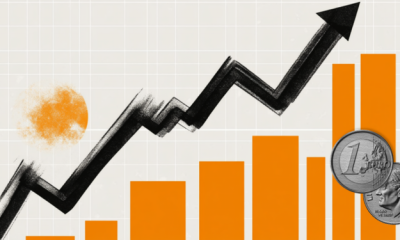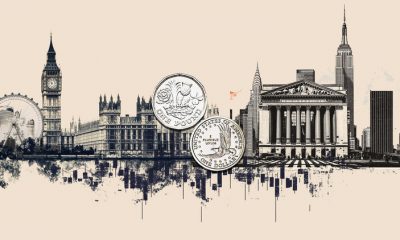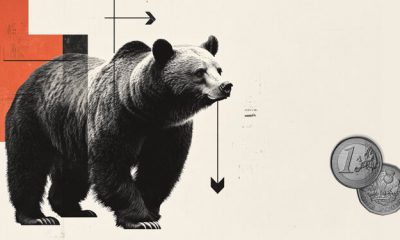![Nifty 50 Index Elliott Wave technical analysis [Video]](https://dripp.zone/news/wp-content/uploads/2025/05/Nifty-50-Index-Elliott-Wave-technical-analysis-Video-Crypto.jpg)
![Nifty 50 Index Elliott Wave technical analysis [Video]](https://dripp.zone/news/wp-content/uploads/2025/05/Nifty-50-Index-Elliott-Wave-technical-analysis-Video-Crypto-560x422.jpg)
others
Dow Jones holds onto recovery levels as investors focus on earnings – Crypto News
The Dow Jones Industrial Average (DJIA) found room on the high side on Wednesday, climbing into a second day of recovery flows and testing territory north of 46,600 before settling back to flat for the day. Another round of Wall Street earnings reports is kicking off the quarterly review period on a high note, with investment bank and luxury handbag earnings outpacing expectations.
Still-rising trade tensions between the US and China are still simmering away on the back burner, and the ongoing US government shutdown remains a key sticking point for global markets, but equities remain focused on earnings, the one blue patch in an otherwise grey sky.
Earnings trump trade wars and non-functioning governments, apparently
Morgan Stanley (MS) and Bank of America (BAC) both beat earnings expectations during the third quarter, rising nearly 6% and 5% respectively, on Wednesday. French luxury goods conglomerate Moet Hennessy Louis Vuitton SE (LVMH) soared over 12% on the day after thumping earnings expectations, further bolstering broad-market expectations that companies will continue to churn out record-setting earnings periods.
Official US datasets remain a large blank space as the Trump administration largely avoids getting involved in solving the federal government’s ongoing funding shutdown. Little indication has been given that the two sides of the US government are in a particular rush to bring an end to the federal closure, sparking comments from Trump aides that a sweeping firing of government workers is now underway. A federal judge in San Francisco issued a sweeping block of any firings by the Trump administration, at the specific request of multiple federal worker unions, a move that will both draw ire from President Trump and further assuage any concerns about long-term fallout from the shutdown for investors.
Investors also continue to brush off any negative outcomes from the government data freeze, largely due to a lack of any official reporting on labor, wages, and employment makes it easier for the Federal Reserve (Fed) to maintain its near-term trajectory of delivering two more interest rate cuts before the end of the year.
Dow Jones daily chart
Fed FAQs
Monetary policy in the US is shaped by the Federal Reserve (Fed). The Fed has two mandates: to achieve price stability and foster full employment. Its primary tool to achieve these goals is by adjusting interest rates.
When prices are rising too quickly and inflation is above the Fed’s 2% target, it raises interest rates, increasing borrowing costs throughout the economy. This results in a stronger US Dollar (USD) as it makes the US a more attractive place for international investors to park their money.
When inflation falls below 2% or the Unemployment Rate is too high, the Fed may lower interest rates to encourage borrowing, which weighs on the Greenback.
The Federal Reserve (Fed) holds eight policy meetings a year, where the Federal Open Market Committee (FOMC) assesses economic conditions and makes monetary policy decisions.
The FOMC is attended by twelve Fed officials – the seven members of the Board of Governors, the president of the Federal Reserve Bank of New York, and four of the remaining eleven regional Reserve Bank presidents, who serve one-year terms on a rotating basis.
In extreme situations, the Federal Reserve may resort to a policy named Quantitative Easing (QE). QE is the process by which the Fed substantially increases the flow of credit in a stuck financial system.
It is a non-standard policy measure used during crises or when inflation is extremely low. It was the Fed’s weapon of choice during the Great Financial Crisis in 2008. It involves the Fed printing more Dollars and using them to buy high grade bonds from financial institutions. QE usually weakens the US Dollar.
Quantitative tightening (QT) is the reverse process of QE, whereby the Federal Reserve stops buying bonds from financial institutions and does not reinvest the principal from the bonds it holds maturing, to purchase new bonds. It is usually positive for the value of the US Dollar.
-

 Blockchain1 week ago
Blockchain1 week agoIt’s About Trust as NYSE Owner, Polymarket Bet on Tokenization – Crypto News
-

 De-fi1 week ago
De-fi1 week agoGrayscale Launches Staking for Ethereum and Solana Spot Crypto ETPs – Crypto News
-

 Technology1 week ago
Technology1 week agoDiwali bonanza: iPhone 16 Pro Max price crashes by up to ₹55,000 on Flipkart – Don’t miss out! – Crypto News
-
![CSX Corp. (CSX) Stocks Elliott Wave technical analysis [Video]](https://dripp.zone/news/wp-content/uploads/2025/02/CSX-Corp-CSX-Stocks-Elliott-Wave-technical-analysis-Video-400x240.png)
![CSX Corp. (CSX) Stocks Elliott Wave technical analysis [Video]](https://dripp.zone/news/wp-content/uploads/2025/02/CSX-Corp-CSX-Stocks-Elliott-Wave-technical-analysis-Video-80x80.png) others6 days ago
others6 days agoDow Jones slides to one-week low as government shutdown persists – Crypto News
-

 others1 week ago
others1 week agoEUR/USD holds modest bid amid US shutdown and mixed PMI readings – Crypto News
-
![CSX Corp. (CSX) Stocks Elliott Wave technical analysis [Video]](https://dripp.zone/news/wp-content/uploads/2025/02/CSX-Corp-CSX-Stocks-Elliott-Wave-technical-analysis-Video-400x240.png)
![CSX Corp. (CSX) Stocks Elliott Wave technical analysis [Video]](https://dripp.zone/news/wp-content/uploads/2025/02/CSX-Corp-CSX-Stocks-Elliott-Wave-technical-analysis-Video-80x80.png) others6 days ago
others6 days agoDow Jones slides to one-week low as government shutdown persists – Crypto News
-

 Metaverse1 week ago
Metaverse1 week agoIs AI really stealing your job? New Yale study fact-checks claims and finds out the culprits – Crypto News
-

 Metaverse4 days ago
Metaverse4 days agoWhat Satya Nadella’s latest shakeup says about Microsoft’s evolving AI strategy – Crypto News
-

 Metaverse4 days ago
Metaverse4 days agoWhat Satya Nadella’s latest shakeup says about Microsoft’s evolving AI strategy – Crypto News
-

 Technology4 days ago
Technology4 days agoAI isn’t the dot-com bubble, but that won’t stop it from ending badly – Crypto News
-

 Metaverse1 week ago
Metaverse1 week agoHow AI search is disrupting SEO, e-commerce and journalism – Crypto News
-

 Cryptocurrency1 week ago
Cryptocurrency1 week agoEthereum can rally to $5,900 in October – but ONLY IF… – Crypto News
-
Business1 week ago
Whale Dumps Massive $55 Million in XRP to Ripple as Coin Falls Below $3? – Crypto News
-
Technology1 week ago
Fed’s Schmid Signals Opposition to Further Rate Cuts With Inflation ‘Too High’ – Crypto News
-

 Blockchain1 week ago
Blockchain1 week agoOndo Secures SEC-Registered Infrastructure With Oasis Pro Acquisition – Crypto News
-
Technology1 week ago
Gold Vs Bitcoin – Peter Schiff Predicts BTC Will Be ‘Rugged by Gold’ – Crypto News
-

 Blockchain1 week ago
Blockchain1 week agoBNY Explores Blockchain Payments Using Tokenized Deposits – Crypto News
-

 Blockchain1 week ago
Blockchain1 week agoCoinbase Premium Gap Signals Strongest Bitcoin Accumulation Since ETF Launch – Details – Crypto News
-

 Blockchain6 days ago
Blockchain6 days agoEurope’s Digital Asset Rules Have A Transferability Blind Spot – Crypto News
-

 Technology4 days ago
Technology4 days agoChatGPT will soon pay for you! India’s AI payment pilot set to go live: What it means for users – Crypto News
-

 Technology1 week ago
Technology1 week agoDiscord user data leaked after breach at customer service partner: Here’s what was exposed – Crypto News
-

 others1 week ago
others1 week agoGBP/USD rises as US shutdown prolongs, Fed data gap grows – Crypto News
-
Technology1 week ago
ASTER Token Rockets Over 10% in an Hour as Binance Announces Spot Listing – Crypto News
-

 Technology1 week ago
Technology1 week agoOxygenOS 16 to launch in India on October 16: List of OnePlus devices likely to get the update – Crypto News
-

 Technology1 week ago
Technology1 week agoThe AI Suicide Problem Knows No Borders – Crypto News
-

 De-fi1 week ago
De-fi1 week agoGLXY Jumps 8% as Galaxy Digital Launches Retail Platform – Crypto News
-

 Blockchain1 week ago
Blockchain1 week agoIs A $10,000 Ethereum Price Within Reach? Here’s What Experts Are Forecasting Next – Crypto News
-

 Technology1 week ago
Technology1 week agoOnePlus 15T tipped to launch in early 2026 with Snapdragon 8 Elite Gen 5 chipset: Report – Crypto News
-
Business7 days ago
5 Reasons Why ZA Miner is the Leading Blockchain Mining Platform on the Market? – Crypto News
-

 Technology6 days ago
Technology6 days agoMeta AI on Instagram can now dub your reels in Hindi: here’s how the feature works – Crypto News
-
Business6 days ago
Senate Democrats’ New DeFi Regulation Proposal Stalls Crypto Market Structure Talks – Crypto News
-

 Cryptocurrency1 week ago
Cryptocurrency1 week ago150% Surge on Trump Media Partnership – Crypto News
-
Business1 week ago
Aster Token Crashes 10% On DEX Integrity Issues Ahead of Airdrop, What’s Happening? – Crypto News
-

 Blockchain1 week ago
Blockchain1 week agoSolana (SOL) Spikes Higher – Bulls Tighten Grip As Market Heats Up Again – Crypto News
-
others1 week ago
Kalshi Founder Reveals the Most Profitable Vertical for Prediction Markets – Crypto News
-

 Blockchain1 week ago
Blockchain1 week agoAI Bitcoin Price Model Says BTC Will Stay Rangebound in October – Crypto News
-

 others1 week ago
others1 week agoWatching the 150 line in the sand – OCBC – Crypto News
-

 Technology1 week ago
Technology1 week agoOnePlus confirms Android 16-powered OxygenOS 16 to launch in India on 16 October, teases new AI features – Crypto News
-

 Cryptocurrency1 week ago
Cryptocurrency1 week agoCardano (ADA) eyes $0.89 breakout as Bitcoin steals the spotlight – Crypto News
-
Technology1 week ago
Ethereum’s Price Bullish Cycle Resumes as Grayscale Launches Spot Staking ETPs – Is $7,331 Next? – Crypto News
-

 De-fi1 week ago
De-fi1 week agoBitcoin Surges Above $125,000 as ‘Uptober’ Rally Continues for Sixth Day – Crypto News
-

 Blockchain1 week ago
Blockchain1 week agoPolygon Proposal Seeks to End POL Inflation, Add Buybacks – Crypto News
-

 others1 week ago
others1 week agoFedspeak expected to grab all the attention – Crypto News
-

 Cryptocurrency1 week ago
Cryptocurrency1 week agoIndia to Roll Out RBI-Linked Digital Currency Amid Dismissal of Crypto With ‘No Backing’ – Crypto News
-

 Cryptocurrency1 week ago
Cryptocurrency1 week agoHow to Create A Meme Coin And Make Money Out of It – Crypto News
-

 Technology1 week ago
Technology1 week agoApple silently fixes Apple Intelligence bug that stopped iPhone 17 users from using AI features – Crypto News
-

 De-fi1 week ago
De-fi1 week agoICE Invests $2 Billion in Polymarket To Expand Into Prediction Markets – Crypto News
-

 Technology1 week ago
Technology1 week agoAnthropic CEO Dario Amodei to visit India this week as Claude AI maker plans first office in Bengaluru – Crypto News
-

 Metaverse1 week ago
Metaverse1 week agoIs AI reshaping India’s business landscape? CCI study finds 67% startups focus on applications, 76% use open source tech – Crypto News
-

 Blockchain7 days ago
Blockchain7 days ago5 Key Factors Behind Its Growing Value – Crypto News




